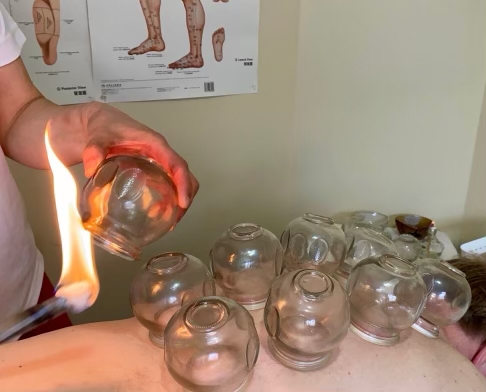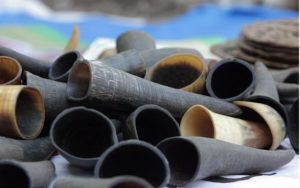The focus and desired outcome of cupping is the release of pain and increased blood flow in the treated area. Cupping works in much the same way as acupuncture by stimulating the blood flow in and around the meridians or acupoints to remove blockages assumed to be preventing qi (vital life energy) from flowing smoothly around the body. This is a welcomed addition to a lower back massage for anyone suffering from discomfort in their lower back area.
Reportedly cupping has the following additional benefits:
- Cupping helps to reduce pain and inflammation.
- Cupping improves blood flow.
- It is used for relaxation, well-being and deep tissue massage.
- It is a safe, non-invasive and inexpensive treatment.
- Rejuvenation of body organs.
- Facilitates the healing process and strengthens the immune system.
- Used to treat:
- Blood disorders such as anemia and hemophilia
- Rheumatic diseases such as arthritis and fibromyalgia
- Gynecological disorders
- Skin problems: eczema and acne
- High blood pressure
- Migraines, Anxiety and depression
- Varicose veins
It was, so to speak, brought into the modern worldwide mainstream media in 2016, at the Rio Olympics, when Michael Phelps appeared in the pool with round dark bruising on his back and shoulders. When asked by a reporter, he said he used cupping in order to reduce muscle stiffness and pain. This point forward cupping has become more than a fade, and seeing bruising on most people’s bodies is quite common. However, what is really important is finding the correct skilled partitioner in the discipline of cupping.
Sometimes referred to as Decompression Cupping Therapy, there are a number of methods used to deliver the effect. At Beauty-Full Spa & Weight Loss Treatment Centre Pickering, Fire/Sliding Cupping is a technique where massage oils are applied; cups are attached to the body and then slid across to the targeted area. This is an enjoyable part of the treatment as the heat is felt through the skin during this movement and is sensuous. Different sizes of custom-made glass jars are used just for this purpose. This method has been found to be the most efficient method and is needle-free. Unlike other types of jars or cones used, the glass allows the practitioner to see the effectiveness of the treatment.
A wad of alcohol-soaked cotton wool is lit on fire and briefly inserted into the open end of the cup. It is a very fast process with only a few seconds required to generate sufficient heat inside the cup, and the heat source is removed. Next, the cup is quickly inverted and strategically placed on the client’s skin over the area to be treated. The burning of the cotton wool removes all oxygen which creates a vacuum inside the cup so that when it is inverted and placed on the body, it draws up the skin and flesh beneath as it cools, creating a vacuum.
The cup is left in place for 5-10 minutes or longer if required, during which time it exerts a gentle pressure on the meridian, opens the pores, stimulates the blood’s circulation, breaks down obstructions, allows toxins to flow out of the acupoint and in this way realigns and balances the healthy flow of qi.
Cupping is one of the oldest known treatments for multiple illnesses. Throughout history, cupping techniques and styles have often resembled the geographic locations they were practiced in, as well as utilizing a region’s local materials: animal horns, bamboo, ceramic, glass, metal, and plastic have all been used in this practice found in Ancient Egyptian, Chinese, Unani, Korean, Tibetan, and Latin American cultures, all of which have served the purpose of supporting the body’s ability to heal itself. In North Africa, cupping therapy was first documented on Eber’s papyrus (1550 BCE), where a cup is an Egyptian glyph to reference a physician. In Asia, during the Jin dynasty, Ge Hong (281-341 CE) mentions the use of animal horns as a means of draining fluids from the body.
This ancient Chinese practice of cupping is in The Handbook of Prescriptions, an early fourth-century text written by the herbalist Ge Hong. It appears to have become particularly popular during the Qing and Tang dynasties, with herbalist manuals from this era describing the practice in great detail. The beneficial effects include alleviating headaches, abdominal pain and dizziness.
In Arabic and Islamic countries, cups (Hijama) are recommended in the Al-Qanun Fi’l-Tibb, Canon of Medicine (1025CE), to treat menstrual conditions. Prophet Muhammed is reported to have been a user and also advocated about it.
According to Galen, the principle of indication for bloodletting is to eliminate residues or divert blood from one part to another.
In Chinese medicine, cupping and other similar therapies follow the Daoist model of holism. Holism is the philosophy that systems and their properties must be viewed together, not just as a collection of parts. Daoists contended that no single being or human could exist unless they are seen in relation to nature, as an extension of the universe and as such are impacted by natural phenomena, such as the seasons and climate, as well as by internal states, such as emotional stress. Disease, according to this concept, is the result of climate, emotions, and/or trauma that creates an imbalance in the body.
Since Chinese medicinal researchers focus on observable principles of balance examined in living bodies, their traditional medicine practices are considered “alternative” by the dominant medical systems, despite having been practiced for centuries in cultures and countries around the world.
Over time, healers or practitioners have used Horn (suction cups); Glass (fire glass cups): Plastic (hijama cups); Bamboo (wooden cups); Silicone (facial cups), Nabhi (pump cups). The pictures below were taken in 2017 of an Indonesian street therapist using the traditional water buffalo horns.


 The carved out animal horns with sanded edges to form a seal on the surface of the skin would be heated and placed upside down on the skin. The heat would create a vacuum over the desired meridian or acupoint (the points where different circuits of qi – vital life energy – intersect).
The carved out animal horns with sanded edges to form a seal on the surface of the skin would be heated and placed upside down on the skin. The heat would create a vacuum over the desired meridian or acupoint (the points where different circuits of qi – vital life energy – intersect).
Cupping is generally used on the fleshier areas of the body, such as the stomach, back, and occasionally legs and arms. The exact number of cups used and the amount of time they are left in place depends on the condition being treated.
Cupping is primarily used in China as a treatment for congestion, asthma, bronchitis and other respiratory disorders, some types of pain, and gastroenteritis and other abdominal conditions. It can also help to reduce swelling and alleviate depression.
There are many pictures on Google Images showing “after cupping pictures,” do not be alarmed. The pink area (as it appears on a white person) left after cupping can look very traumatic and painful. The only side effects may be some slight circular bruising and/or swelling afterwards, which is caused by the drawing up of tiny blood vessels into the vacuum, but this quickly goes down for most people within a day or so of treatment and is not usually painful. For clients with very sensitive skin, the bruising may last a week or two, be assured it does disappear. The general joke is to tell people that you were struck by an octopus.

Cupping is not suitable for every person. People who suffer from convulsions, inflamed skin or who have a high fever, are suffering from inflammation, taking a blood thinner or bleed easily should not undergo cupping. Pregnant women should avoid cupping on the lower back and stomach. In addition, an experienced practitioner will not usually move cups over bony parts of the body, such as the shoulder blades or spinal bumps. Cupping is considered a low-risk therapy. The side effects will typically occur during your treatment or immediately after. Lightheadedness or dizziness, sweating or nausea may be experienced.


